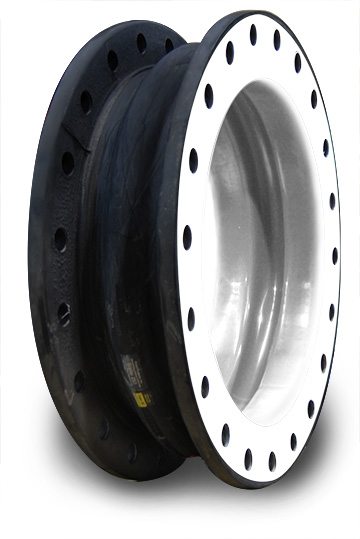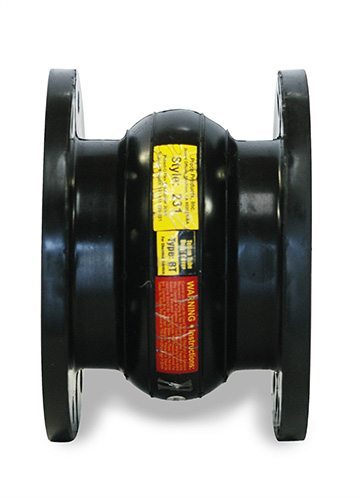Proco Style 251/BT
The Proco Series 251/BT Lined Expansion Joints are designed for tough, demanding, corrosive chemical applications such as chemical and petrochemical process facilities and highly corrosive industrial piping and pollution control systems. Use of the 251/BT expansion joints is especially prevalent in the paper industry, where their ability to resist corrosive attack at elevated temperature and pressure is unrivaled by other competitive metal or plastic expansion joints.
Series 251/BT expansion joints are chemically resistant against the entire pH range, and can easily handle tough pulp/paper applications including:
- White-green-black liquor
- Beach plant chlorination
- Caustic extraction stages
The new 251/BT will replace the Proco Series FFP lined rubber expansion joint. This new, improved product has been completely re-engineered to provide even more strength, flexibility and movement capabilities. Manufactured using tire cord industry technology, the Series 251/BT combines woven polyester tie cord into a fabric matrix, which is then bonded with a Chlorobutyl elastomer that is reinforced with wire and bonded to a PTFE liner. This combination creates a product with an increased operating performance.
Some notable features of the Proco Series 251/BT include:
- Greater movements with a lower/wider arch profile
- Chemical service capability at minimal cost
- Absorption of pipe movements and stress
- Reduction of system noise
- Isolation of mechanical vibrations
- Compensation for alignment/offset
- Elimination of electrolytic action and electrolysis
- Protection against start up and surge forces
For more information about the features and benefits of the Proco Series 251/BT, download our brochure.
For up-to-date pricing and availability information, contact PROCO today.
| Expansion Joint Size Nom. I.D. x Inch/(mm) | Neutral Length Inch/(mm) | 251/ET Movement Capability: From Neutral Position | Operating Condition | Weight in LBS/(kgs) | Flange Dimension and Drilling | |||||||||||||
| Axial Compression Inch/(mm) | Axial Extension Inch/(mm) | Lateral Deflection Inch/(mm) | Angular¹ Deflection Degrees | Torsional² Rotation Degrees | Thrust Factor³ In2/(cm2) | Positive PSIG/(Bar) | Vacuum Inches of Hg/ (mm of Hg) | Joint Assembly | Retaining Ring Set | Control Unit Assembly | O.D. of Exp. Joint/ Ring Inch/ (mm) | Bolt Circle Inch/ (mm) | Number of Holes | Size of Holes Inch/(mm) | ||||
| 19,10 | (25) | 6 | (150) |
1.0 |
0.5 |
0.7 |
35.8° | 1° |
0.8 |
225 |
26 |
3.0 |
2.0 |
2.3 |
4.3 (108.0) |
3.13 |
4 |
0.625 |
| 1.59 | (40) |
0.5 |
0.7 |
29.9° | 1° |
1.8 |
225 |
26 |
6.0 |
2.5 |
2.3 |
5.0 |
3.88 |
4 |
0.625 |
|||
| 29 | (50) |
0.5 |
0.7 |
25.2° | 1° |
3.1 |
225 |
26 |
7.0 |
4.0 |
2.8 |
6.0 |
4.75 |
4 |
0.750 |
|||
| 2.59 | (65) |
0.5 |
0.7 |
20.6° | 1° |
4.9 |
225 |
26 |
7.5 |
4.5 |
2.8 |
7.0 |
5.50 |
4 |
0.750 |
|||
| 3 | (80) |
0.5 |
0.7 |
17.4° | 1° |
7.1 |
225 |
26 |
9.5 |
5.5 |
2.8 |
7.5 |
6.00 |
4 |
0.750 |
|||
| 4 | (100) |
0.5 |
0.7 |
13.2° | 1° |
12.6 |
225 |
26 |
13.0 (5.9) |
8.0 |
2.8 |
9.0 |
7.50 |
8 |
0.750 |
|||
| 5 | (125) |
0.5 |
0.7 |
12.0° | 1° |
19.6 |
225 |
26 |
14.0 |
8.5 |
4.0 |
10.0 |
8.50 |
8 |
0.875 |
|||
| 6 | (150) |
0.5 |
0.7 |
11.1° | 1° |
28.3 |
225 |
26 |
16.0 |
9.5 |
4.0 |
11.0 |
9.50 |
8 |
0.875 |
|||
| 8 | (200) |
1.5 |
0.7 |
1.0 |
8.4° | 1° |
50.3 |
225 |
26 |
20.0 |
14.5 |
8.0 |
13.5 |
11.75 |
8 |
0.875 |
||
| 10 | (250) | 8 | (200) |
0.7 |
1.0 |
8.1° | 1° |
78.5 |
225 |
26 |
28.0 |
17.0 |
10.0 |
16.0 |
14.25 |
12 |
1.000 |
|
| 12 | (300) |
0.7 |
1.0 |
7.3° | 1° |
113.1 |
225 |
26 |
44.0 |
24.5 |
10.0 |
19.0 |
17.00 |
12 |
1.000 |
|||
| 14 | (350) |
0.7 |
1.0 |
6.3° | 1° |
153.9 |
150 |
26 |
50.0 |
27.0 |
12.0 |
21.0 |
18.75 |
12 |
1.125 |
|||
| 16 | (400) |
0.7 |
1.0 |
5.9° | 1° |
201.1 |
150 |
26 |
59.0 |
33.5 |
15.0 |
23.5 |
21.25 |
16 |
1.125 |
|||
| 18 | (450) |
0.7 |
1.0 |
5.3° | 1° |
254.5 |
150 |
26 |
68.0 |
34.0 |
16.5 |
25.0 |
22.75 |
16 |
1.250 |
|||
| 20 | (500) |
1.7 |
0.7 |
1.0 |
4.8° | 1° |
314.2 |
150 |
26 |
79.0 |
38.0 |
16.5 |
27.5 |
25.00 |
20 |
1.250 |
||
| 24 | (600) | 10 | (250) |
0.7 |
1.0 |
3.9° | 1° |
452.4 |
150 |
26 |
91.0 |
48.0 |
20.0 |
32.0 |
29.50 |
20 |
1.375 |
|
| 30 | (750) |
0.7 |
1.0 |
3.8° | 1° |
706.9 |
125 |
26 |
129.0 |
63.0 |
29.5 |
38.8 |
36.00 |
28 |
1.375 |
|||
| 36 | (900) |
0.7 |
1.0 |
3.1° | 1° |
1017.9 |
125 |
26 |
160.0 |
76.0 |
43.0 |
46.0 |
42.75 |
32 |
1.625 |
|||
| 48 | (1200) | 12 | (300) |
0.7 |
1.0 |
2.7° | 1° |
1809.6 |
100 |
26 |
244.0 |
132.0 |
44.0 |
59.5 |
56.00 |
44 |
1.625 |
|
Notes:
1. The degree of angular movement is based on the maximum rated extension.
2. Torsional movement is expressed when the expansion joint is a neutral length.
3. To determine “end thrust”, multiply thrust factor by operating pressure of system.
4. Pressure rating is based on 170°F operating temperature. At higher temperature
the pressure rating is slightly reduced.
5. Weights are approximate.
6. Control unit weight consists of one rod, four washers, three nuts and two control rod plates.
Multiply number of control units needed for application (as specified in the Fluid Sealing Association
Technical Handbook) to determine correct weights.
7. Dimensions shown are in accordance with 125/150# standards of ANSI B-16.1, B-16.24, B-16.5;
AWWA C-207 Table 1 and 2 Class D.
8. 1″ I.D. through 12″ I.D. have white PTFE liners. 12″ I.D. through 48″ I.D. have clear FEP liners.
9. Teflon liner extends to bolt holes’ center line only.
10. Available in filled arch configuration only.









